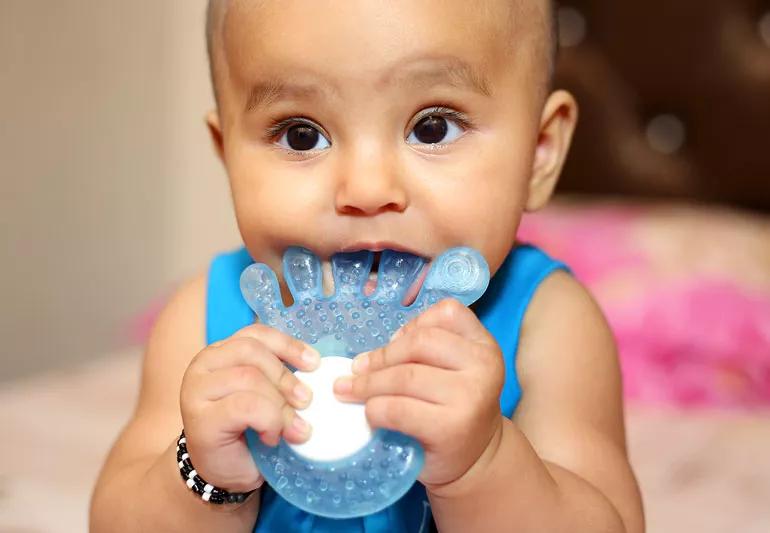Teething is a natural phase in child development, typically beginning when babies start teething around 6 to 9 months of age. This period marks the emergence of a child’s primary teeth through the gums, a process which continues until about 3 years old when all 20 primary teeth are usually in place. As a fundamental aspect of child development, teething can result in discomfort and swollen gums, influencing a child’s behavior and sleep patterns—symptoms that caregivers should be readily able to recognize and manage.
Awareness of teething symptoms and the implementation of effective soothing strategies are crucial for parents and caregivers during this milestone. This article seeks to provide a comprehensive understanding of the signs of teething in babies, address common concerns such as teething fever and the premise of a teething baby’s runny nose, and offer guidance on when to consult a pediatric dentist. Additionally, it will explore the relationship between teething and child development, ensuring caregivers are equipped with the knowledge to support their children through this pivotal stage.
Understanding Teething: A Developmental Milestone

Teething is a significant developmental milestone that typically begins around 6 months of age, although the timing can vary, with some babies starting as early as 3 months or as late as 12 months. Interestingly, girls often start teething before boys. The process marks the arrival of a baby’s first set of teeth – 20 primary teeth that are already present in the jawbone at birth. Here’s a closer look at the stages of teething:
Initial Stage: The lower central incisors are usually the first to emerge, followed by the upper central incisors. These are the bottom and top front teeth, respectively.
Teething Sequence: After the incisors, the teeth typically appear in the following order: lateral incisors (next to the middle teeth), first molars (the larger back teeth used for grinding food), canines (pointed teeth beside the incisors), and finally the second molars.
Completion: By the time a child reaches 3 years old, most will have their full set of baby teeth.
Parents should monitor their child’s teething progress and consult a pediatric dentist if there are concerns. For instance, if a baby has not started developing teeth by 18 months, it’s advisable to seek professional advice. Remember, teething is a natural part of child development, and while the timing may vary, the appearance of that first tooth is a momentous occasion in a baby’s growth.
Signs and Symptoms of Teething

As caregivers navigate the milestones of child development, recognizing the signs of teething in babies is crucial. Here are the key symptoms to look out for:
Gum Sensitivity and Eating Habits:
- A noticeable decrease in solid food intake may occur due to gum swelling and tenderness before a tooth breaks through.
- Not every teething baby will lose their appetite; this affects only about one-third of babies.
Classic Teething Indicators:
- Excessive drooling and the tendency to chew on objects are common.
- Babies might display irritability or crankiness due to sore or tender gums.
- A slight increase in temperature might be observed, although it should not reach fever levels.
Misconceptions and Clarifications:
- Contrary to popular belief, teething does not cause high fever or diarrhea.
- Swollen or puffy areas on the gums can signal the imminent emergence of a tooth.
- While babies frequently put their fingers or fists in their mouth, this behavior is not exclusive to teething.
- Symptoms may include a mild fever (less than 102° F), decreased appetite, and increased drooling or fussiness.
- True fever, higher than 102° F, is not a result of teething and may indicate another illness or infection.
Understanding these symptoms helps caregivers provide the right support and decide when consulting a pediatric dentist is necessary. It’s essential to observe these signs closely and maintain a nurturing environment for a teething baby.
Read : Ear Infections Relief : Home Remedies for Ear Ache!
How to Soothe a Teething Child
When do babies start teething, parents often seek methods to soothe their teething baby. While teething symptoms can be distressing, there are several safe and effective remedies to help ease a child’s discomfort:
Gentle Pressure on Gums:
- Rub the baby’s gums with a clean finger or a moist gauze pad to provide relief.
- Offer cool, soft foods like refrigerated fruit purees or chilled yogurt, which can be comforting.
- Provide hard foods for counterpressure, such as carrot sticks or bread crusts, if the baby is already eating solid foods.
Teething Objects:
- Use a clean teether for the baby to chew on, but avoid liquid-filled ones that could break.
- Teething rings cooled in the fridge (not frozen) can help soothe gums.
- Ensure teething toys are free from harmful chemicals and are not too hard, to prevent damage to the gums.
Pain Relief Options:
- If non-medical options aren’t sufficient, paracetamol or ibuprofen specifically designed for young children can be used, following the instructions or after consulting a GP.
- Avoid teething gels, as they may be washed away by drooling and could contain substances like benzocaine or lidocaine, which are harmful to babies.
Parents should steer clear of teething tablets containing belladonna, amber teething necklaces, and any products that pose a choking hazard. Always consult a pediatric dentist if you are unsure about the best way to support your teething child’s development.
The Role of Nutrition During Teething

Proper nutrition plays a pivotal role in supporting a teething baby’s oral health and overall child development. As little ones experience the discomfort of emerging teeth, it’s essential to focus on providing nutrients that are foundational for strong teeth and gums. Here are the key nutrients and their dietary sources that can benefit a teething child:
- Calcium: This mineral is crucial for developing strong teeth and bones. Calcium-rich foods include:
- Dairy products like milk, cheese, and yogurt
- Seafood such as shrimp, crab, and fish
- Plant-based options like soybeans and dark green vegetables like spinach and kale
- Vitamin D: Essential for the absorption of calcium and phosphorus, Vitamin D can be sourced from:
- Sunlight, which naturally stimulates the body to produce Vitamin D
- Foods like cod liver oil and chicken eggs
- Synthetic supplements, if dietary intake and sunlight exposure are insufficient
- Phosphorus and Magnesium: Both minerals are vital for healthy teeth development, with phosphorus found in animal meats and magnesium in:
- Seafood including shrimp and fish
- Nuts and legumes
- Green vegetables such as spinach
- Vitamin C and Vitamin A: These vitamins support collagen synthesis and overall oral health, with rich sources being:
- Citrus fruits like oranges, tangerines, and grapefruit for Vitamin C
- Red or yellow fruits and vegetables, eggs, and liver for Vitamin A
In addition to incorporating these nutrients into a teething baby’s diet, it’s advisable to limit sugary drinks and snacks, especially between meals, to prevent tooth decay. By focusing on these dietary essentials, caregivers can help ease teething symptoms and support their child’s oral health journey.
Teething and Oral Hygiene

Maintaining good oral hygiene is vital from the moment a teething baby’s first tooth appears. Here are practical steps to ensure your child’s dental health:
- Before Teeth Emerge:
- Gently wipe the baby’s gums with a damp cloth twice a day to minimize harmful bacteria.
- This routine should start even before the first tooth surfaces and continue throughout the teething process.
First Tooth Care:
- When the first tooth comes in, switch to a soft-bristled infant toothbrush and a tiny smear of infant toothpaste, no larger than a grain of rice.
- Brush gently twice a day, especially after the last meal or drink before bed.
Progressing Oral Care:
- As more teeth appear, introduce flossing to clean between teeth that touch, preventing plaque buildup and cavities.
- Increase the fluoride toothpaste amount to a pea-sized dollop for children over three years old.
- Continue to assist your child with brushing until they have mastered the skill, typically around 7 or 8 years old.
Parents should schedule their child’s first dental visit by their first birthday or six months after the first tooth’s appearance. Regular checkups with a pediatric dentist are essential to monitor teething progress and receive professional guidance. To prevent Early Childhood Caries (ECC), avoid putting your baby to bed with a bottle and limit high sugar intake. If your water supply lacks fluoride, consult with your pediatrician about supplements. By following these steps, caregivers can help ensure their baby maintains a healthy smile throughout their child development journey.
When to Seek Professional Advice
Identifying when teething symptoms may require professional advice is essential for the well-being of your child. Here are clear indicators that it’s time to seek help:
Persistent Discomfort or Severe Symptoms:
- If your child is experiencing ongoing or severe discomfort that doesn’t improve with home remedies, it’s important to consult a pediatric dentist.
- Signs such as persistent crying, refusal to eat, and trouble sleeping may indicate that your baby needs professional evaluation.
Fever, Diarrhea, or Rash:
- While a mild increase in temperature can be considered normal , a fever (temperature over 100.4°F) warrants a call to your pediatrician.
- Diarrhea and rashes are not typical teething symptoms. If these occur, they may suggest other health issues that need medical attention.
Injury-Related Tooth Loss or Other Concerns:
- A tooth lost due to injury, or any other dental concerns, should be addressed by a pediatric dentist promptly.
- Regular well-child check-ups are also crucial to monitor your baby’s overall health and development, including oral health.
Parents should trust their instincts and not hesitate to reach out to healthcare professionals if they have concerns about their child’s teething symptoms or general health. Remember, it’s better to be cautious and get reassurance from a pediatric dentist or doctor than to overlook a potentially serious issue.
FAQs
Q: What methods can assist my child during the teething phase?
A: To aid your child during teething, you can offer a cold teething ring to lessen gum inflammation and provide a safe chewing option. If the discomfort persists and your baby is particularly irritable, over-the-counter pain relievers like acetaminophen (Tylenol) might offer some relief.
Q: How can teething pain be alleviated for children?
A: The American Academy of Pediatrics (AAP) suggests several alternatives to treat teething pain, which include gently rubbing the infant’s gums with a clean finger or giving them a firm rubber teething ring to chew on.
Q: Are there any home treatments for easing teething discomfort?
A: Yes, to soothe sore gums at home, you can:
- Rub your baby’s gums with a clean finger or a moistened gauze pad.
- Provide relief with a cold washcloth, spoon, or chilled teething ring.
- Offer a teething ring for your baby to chew on.
- Give hard foods for babies who are old enough to eat them.
- Keep your baby’s face dry to prevent irritation from drool.
- Consider using an over-the-counter remedy if necessary.
Q: What can help with early signs of teething?
A: If your baby begins to chew on their fingers, toys, or other objects, it may indicate they are teething. For babies 6 months or older, you can provide healthy items to chew on, such as raw fruits and vegetables. Soft fruits like melon can be particularly soothing for their gums.



